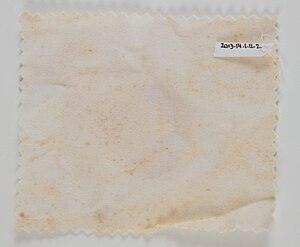
Cloth filters are an extremely simple, low-resource method of cleaning water, using cloth folded to 4 or 8 layers, draped over a wide-mouthed water vessel. In tests, results have varied, but they have reached up to 99% efficacy at removing pathogens.[verification needed]
Old cotton saris work best, and thus the term sari filter (or saree filter) is often used.
In India many of the women wear Sari's. A Sari is a cloth that women wear that is usually very long and unstitched. It is a very traditional garment to be worn. When the women go and fetch the water they often use the Sari cloth as a filter so that the water that they get is cleaner.
Even 99% efficacy may not be good enough on its own, but it is much better than no treatment. It has two important applications:
- people who are too poor to be able to treat water another way (or in a difficult circumstance, thirsty without available water) have a "better than nothing" option.
- it can be used as the first stage of treatment. The water can then be passed through a simple sand filter, for example, or treated by solar water disinfection.
The problem: cholera[edit | edit source]
"Cholera is a waterborne disease that exists in 58 countries. In 2001 there were 184,311 cases of cholera and 2,728 deaths from the disease." (WHO)
The cloth filter was developed in response to widespread cholera in Bangladesh, particularly among those unable to boil or otherwise treat their water.
Summary[edit | edit source]
"...significant reduction in cholera was achieved by filtering out zooplankton, namely copepods, and colonial phytoplankton from household water, both by nylon and sari filtration."
Precautions[edit | edit source]
- Note that efficacy varies a lot depending on cloth used. Do not assume that your folded up synthetic sari or T-shirt will give 99% efficacy - it will probably be much worse (though it should be better than nothing, if there is no alternative).
- 99% removal of certain measured indicator organisms does not mean the water is completely safe - simply that it is safer than it would have been without treatment.
- If it is a new sari made using chemical dyes, some color may be released into the water, with uncertain effects on health. If it is an old sari, as recommended, which has been worn, washed and scrubbed many times, then this is unlikely to be a problem (and is a much smaller problem than the grave danger posed by pathogens).
References[edit | edit source]
- Colwell RR, Huq A, Islam MS, Aziz KM, Yunus M, Khan NH, Mahmud A, Sack RB, Nair GB, Chakraborty J, Sack DA, Russek-Cohen E. Reduction of cholera in Bangladeshi villages by simple filtration. Proc Natl Acad Sci U S A. 2003 Feb 4; 100(3): 1051-1055
- A Huo, B Xu, M A Chowdhury, M S Islam, R Montilla, and R R Colwell A simple filtration method to remove plankton-associated Vibrio cholerae in raw water supplies in developing countries. Appl Environ Microbiol. 1996 July; 62 (7)
Includes content imported from theCylinder at http://web.archive.org/web/20071030011922/http://thecylinder.net:80/:80/2007/05/using-saris-to-reduce-cholera-in.html